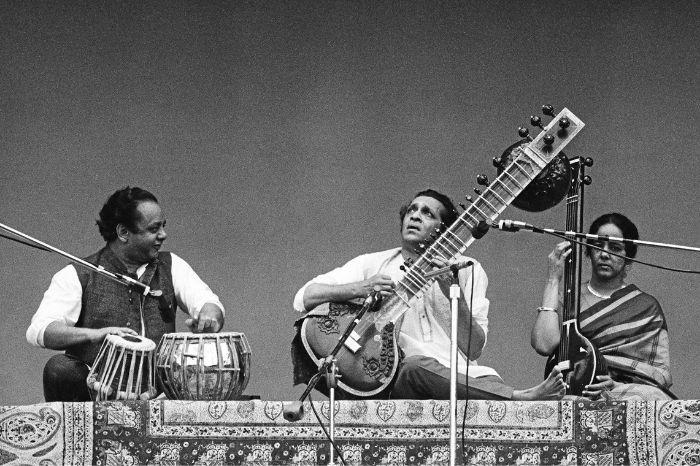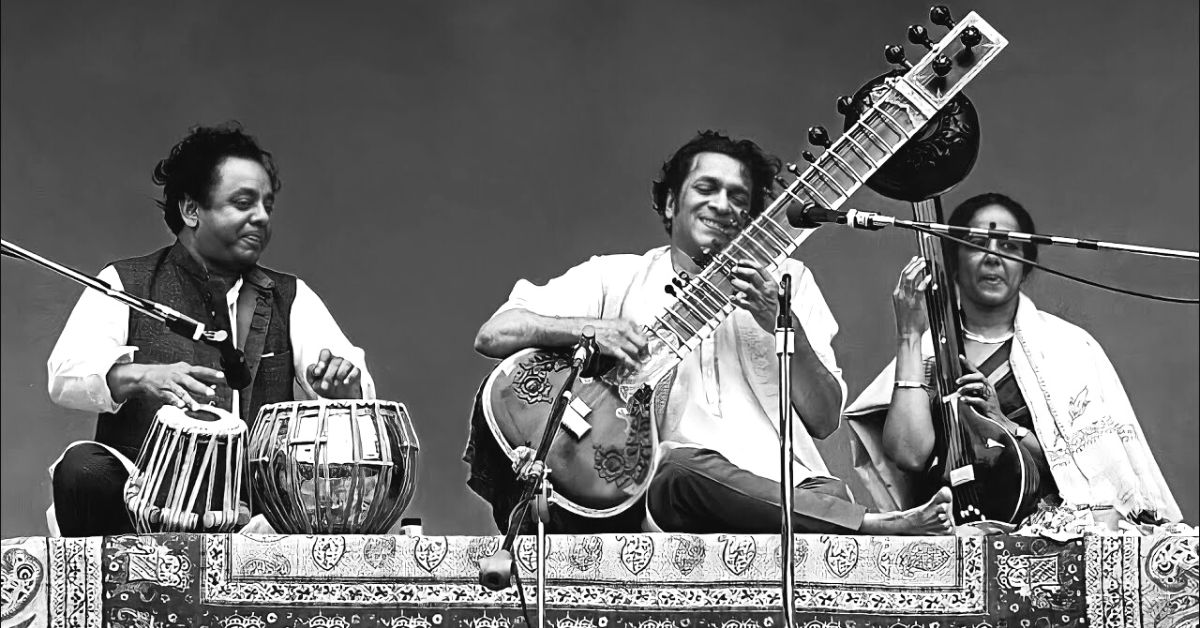On a cloudy Sunday afternoon in July 1967, sitar maestro Pandit Ravi Shankar played a mesmeric four-hour set at the Monterey International Pop Music Festival in California, accompanied by Ustad Allah Rakha on the tabla and Kamala Chakravarty playing the tanpura.
As Ravi Shankar recalled, “[The] Monterey Pop Festival was the real beginning. All the young people were so fresh and so passionate and so drawn to my music. From the moment I started my first stroke on the instrument (sitar), I knew that we were connected.”
“I saw some very famous people in the field of rock and pop music. It was very strange. They were just sitting there, listening to me, swinging away and enjoying themselves. I had seen them perform the night before and they were so different. I was scared after that because their way of presenting the show is so different from ours. I didn’t realise it then, I was excited, but later on so many people told me how it did change their life, which was very touching,” he added.
In the audience that day was the awe-inspiring guitarist and recording artist Jimi Hendrix, who was mesmerised by the complex ragas he was churning out. Later that evening, Hendrix would famously light his electric guitar up in flames after his legendary performance — his first in front of an American audience. The contrast between two music legends couldn’t be starker.
While one sat cross-legged behind his sitar exuding a stirring calmness while also engaging in virtuoistic jugalbandi with legendary table player Alla Rakha, the other brought with him a ferocious intensity marked by sonic magic that literally ended in flames.

For Western audiences, particularly aficionados of blues and rock music, Hendrix stole the show at Monterey with his incredible music and showmanship. You’ll find a plethora of articles in Western publications stating how the festival “belonged” to him.
Others, however, believe that Ravi Shankar “not only held his own with the best of Jimi Hendrix, Big Brother and the Holding Company, and the Grateful Dead”, but also showed the Western masses where acts like the Byrds and Beatles, particularly George Harrison, were picking up their recent influences from. Marked by unparalleled skill and an incomparable sound, his performance brought Hindustani classical music to the forefront of mainstream Western culture.
In the words of his biographer, Oliver Craske, Ravi Shankar had brought about a ‘Sitar Explosion’ in the West. But at no point did he compromise on his cultural heritage or dilute the complexity of what he was bringing to the table or cater to “lazy notions” of Eastern culture held by Western audiences. In fact, he grew increasingly annoyed “with the lazy understanding of his sacred music, especially the cliché associations of Ragas with drugs and psychedelic kitsch.”
His annoyance grew further after performing at the infamous Woodstock Festival in 1969, and in fact, stopped attending similar pop festivals in the West. You can watch this 1971 interview with talk show host Dick Cavett and artist George Harrison to understand his irritation.
What he demanded from his audience was rigour and attention and that they “get high” on his music. At the same time, however, he wasn’t restricted by tradition.
He collaborated with the likes of Yehudi Menuhin, Philip Glass and Zubin Mehta, and continuously experimented, which gave him such a unique sound.
His daughter Anoushka Shankar, a sitar maestro in her own right, said it best in an interview with NPR, “There’s something really inspiring about being really rooted in order to find our freedom of who we are. What really stays with me about my father is how deeply rooted his music was, and then from that rootedness, how expansive and free his creativity was.”
She added, “He was simultaneously the most knowledgeable person I knew when it came to the intricacies of a deeply, deeply complicated musical style, but he was also the most creative human being I know. It was like a tap for him and he could endlessly create.”
The performance at Monterey also cemented the title George Harrison once gave him, which was the ‘Godfather of World Music’.
As the Grammy Museum elaborates, “What he most likely meant by the title was that Shankar was one of the earliest and certainly most important non-Western music virtuosos to introduce non-Western music to Western pop and rock fans.”
“Though some American classical music followers might have known of Shankar and the intricacies of Indian music prior to the ‘60s, Shankar’s ability to draw — and captivate — young listeners in this country was unprecedented,” the description adds.
As someone who learned how to play the sitar from Ravi Shankar, Harrison understood quite evidently that not only did the Sitar maestor’s music transcend continents, nations and cultures, but also generations.
There were detractors in India, who felt that his association with artists like George Harrison would compromise the aesthetic and spirituality of classical music. They felt the Sitar had no business finding itself in pop songs like ‘Love You To’ or ‘Norwegian Wood’ by The Beatles.
Despite the critics, their relationship remained strong till Harrison’s death in November 2001.
Ravi Shankar took the hits from critics back home to take Indian classical music to the world. In a career spanning more than 60 albums, he “single-handedly introduced Western audiences to the centuries-old classical tradition of Indian Ragas.” And recognition wasn’t too far behind with sold-out arenas and four Grammy Awards, including the Lifetime Achievement Award.
But it was his performance in Monterey which kickstarted the mass adoration he enjoys today and brought real recognition to the centuries-old tradition of Indian classical music in the West.
Sources:
‘The Enduring Afterglow Of Ravi Shankar’s Life In Music’ by Bilal Qureshi; Published on 7 April 2020 courtesy NPR/wbur
‘Ravi Shankar, Open Mind’ by Taylor Ho Bynam; Published on 12 December 2020 courtesy The New Yorker
‘REVISIT: RAVI SHANKAR: A LIFE IN MUSIC’; Published on 8 May 2020 courtesy Grammy Museum
‘Ravi Shankar on The Sitar’s Association With Drugs | The Dick Cavett Show’ courtesy YouTube
Ravi Shankar & Alla Rakha Live in Monterey Pop courtesy YouTube
(Edited by Divya Sethu)
If you found our stories insightful, informative, or even just enjoyable, we invite you to consider making a voluntary payment to support the work we do at The Better India. Your contribution helps us continue producing quality content that educates, inspires, and drives positive change.
Choose one of the payment options below for your contribution-
By paying for the stories you value, you directly contribute to sustaining our efforts focused on making a difference in the world. Together, let's ensure that impactful stories continue to be told and shared, enriching lives and communities alike.
Thank you for your support. Here are some frequently asked questions you might find helpful to know why you are contributing?

